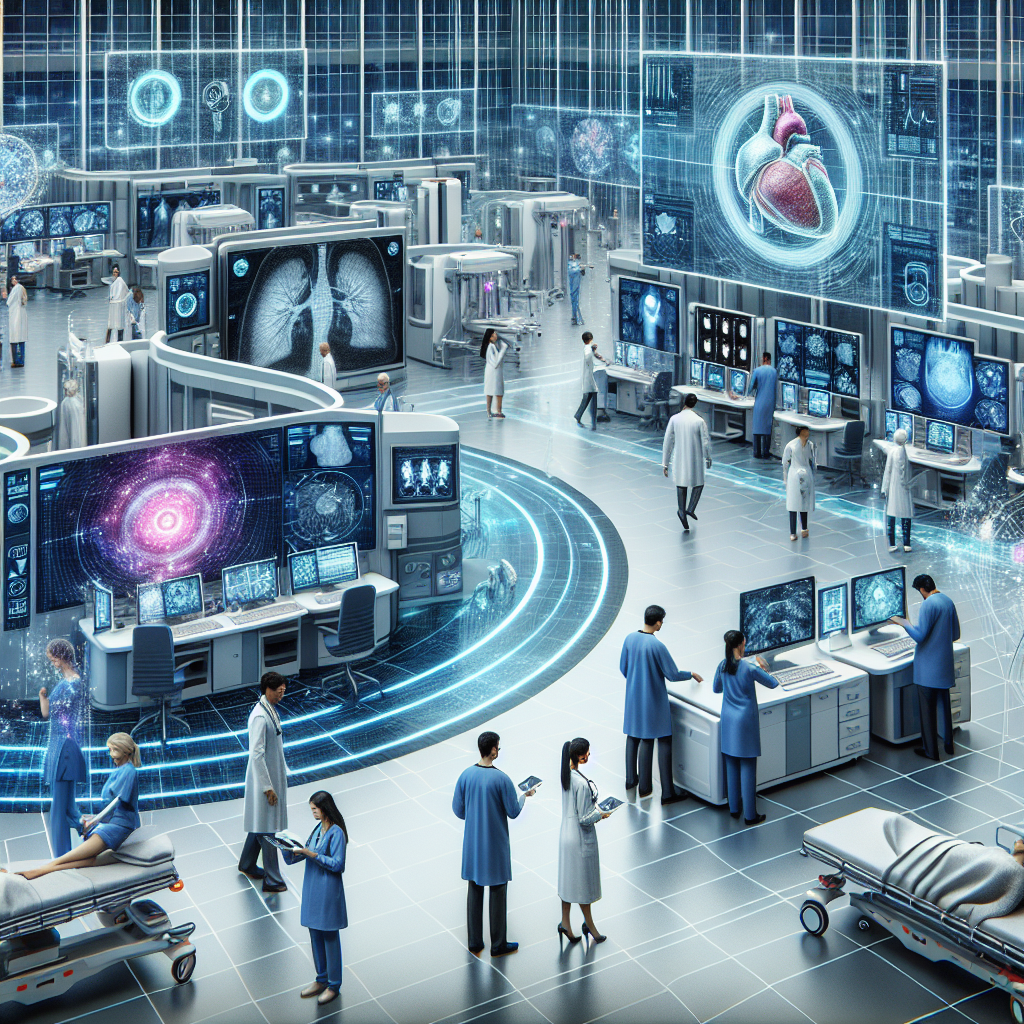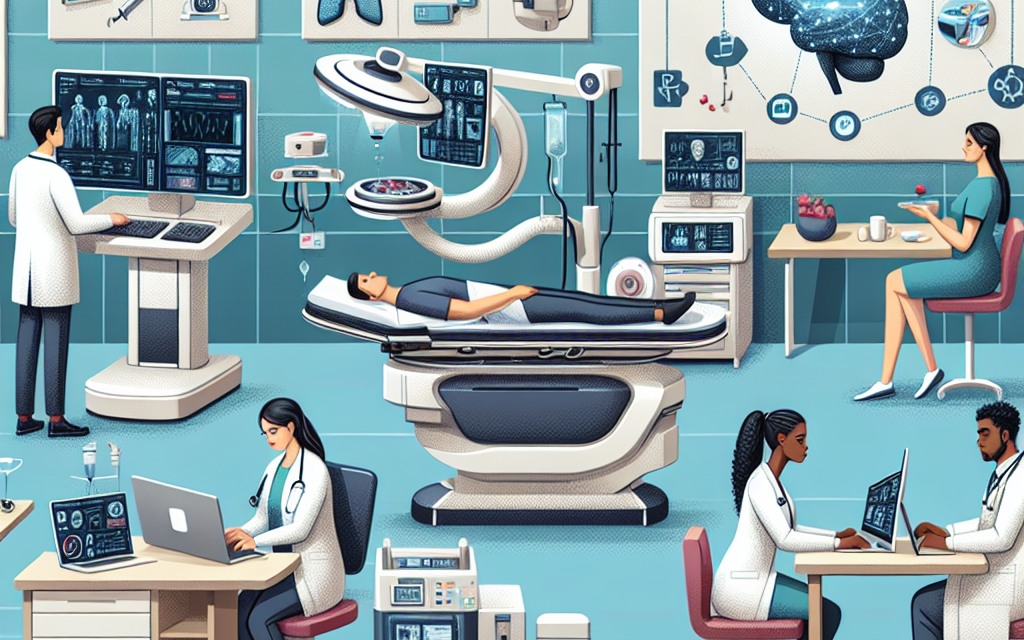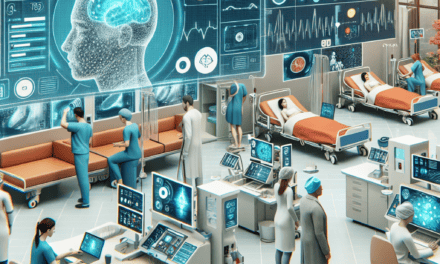Health Systems Adopt AI Imaging Innovations

In recent years, the integration of artificial intelligence (AI) into healthcare systems has revolutionized the way medical imaging is conducted and interpreted. AI imaging innovations are transforming diagnostic processes, improving accuracy, and enhancing patient outcomes. This article delves into the adoption of AI imaging technologies by health systems, exploring their impact, challenges, and future potential.
The Rise of AI in Medical Imaging
The adoption of AI in medical imaging is not just a trend but a significant shift in healthcare practices. AI technologies, particularly machine learning and deep learning, have shown remarkable capabilities in analyzing complex medical images with precision and speed. This section explores the factors driving the rise of AI in medical imaging.
Technological Advancements
AI’s integration into medical imaging has been propelled by rapid technological advancements. The development of sophisticated algorithms and the availability of large datasets have enabled AI systems to learn and improve over time. These technologies can now identify patterns and anomalies in medical images that might be missed by the human eye.
For instance, convolutional neural networks (CNNs), a type of deep learning model, have been particularly effective in image recognition tasks. CNNs can process and analyze vast amounts of imaging data, making them ideal for applications in radiology and pathology.
Improved Diagnostic Accuracy
One of the most significant benefits of AI in medical imaging is its potential to improve diagnostic accuracy. AI algorithms can analyze images with a level of detail and consistency that surpasses human capabilities. This has led to more accurate diagnoses, particularly in complex cases where subtle differences in imaging can be critical.
Studies have shown that AI can match or even exceed the performance of radiologists in certain diagnostic tasks. For example, a study published in Nature in 2020 demonstrated that an AI system outperformed radiologists in detecting breast cancer from mammograms, reducing false positives and negatives.
Efficiency and Workflow Optimization
AI imaging innovations also contribute to increased efficiency and optimized workflows in healthcare settings. By automating routine tasks, AI allows radiologists and other healthcare professionals to focus on more complex cases and patient care.
AI systems can quickly process and prioritize imaging studies, reducing the time needed for diagnosis and treatment planning. This is particularly beneficial in emergency situations where timely intervention is crucial.
Cost-Effectiveness
The cost-effectiveness of AI imaging technologies is another factor driving their adoption. By improving diagnostic accuracy and efficiency, AI can reduce the need for repeat imaging studies and unnecessary procedures, ultimately lowering healthcare costs.
Moreover, AI can help address the shortage of radiologists in many regions by augmenting their capabilities and allowing them to manage larger caseloads without compromising quality.
Regulatory Support and Industry Collaboration
Regulatory bodies and industry stakeholders are increasingly recognizing the potential of AI in medical imaging. The U.S. Food and Drug Administration (FDA) has approved several AI-based imaging tools, paving the way for broader adoption in clinical practice.
Collaborations between technology companies, healthcare providers, and academic institutions are also fostering innovation and accelerating the development of AI imaging solutions. These partnerships are crucial for ensuring that AI technologies are safe, effective, and aligned with clinical needs.
Applications of AI in Medical Imaging
AI imaging innovations are being applied across various medical specialties, each with unique challenges and opportunities. This section explores some of the key applications of AI in medical imaging and their impact on patient care.
Radiology
Radiology is one of the primary fields where AI has made significant inroads. AI algorithms are being used to enhance image interpretation, detect abnormalities, and assist in diagnosis.
For example, AI can help identify lung nodules in chest X-rays, detect fractures in bone scans, and assess tumor progression in cancer patients. These capabilities not only improve diagnostic accuracy but also enable earlier detection of diseases, leading to better patient outcomes.
Pathology
In pathology, AI is being used to analyze histopathological images, which are critical for diagnosing diseases such as cancer. AI algorithms can identify patterns and features in tissue samples that may be indicative of malignancy or other pathological conditions.
AI-powered digital pathology platforms are also facilitating remote consultations and second opinions, allowing pathologists to collaborate and share expertise across geographical boundaries.
Ophthalmology
AI is transforming ophthalmology by improving the detection and management of eye diseases. AI algorithms can analyze retinal images to identify signs of diabetic retinopathy, age-related macular degeneration, and glaucoma.
These technologies enable early intervention and personalized treatment plans, reducing the risk of vision loss and improving quality of life for patients.
Cardiology
In cardiology, AI is being used to analyze cardiac imaging data, such as echocardiograms and cardiac MRIs. AI algorithms can assess heart function, detect structural abnormalities, and predict the risk of cardiovascular events.
AI’s ability to process large volumes of data quickly and accurately is particularly valuable in cardiology, where timely diagnosis and intervention can significantly impact patient outcomes.
Oncology
AI is playing a crucial role in oncology by enhancing the accuracy of cancer diagnosis and treatment planning. AI algorithms can analyze imaging data to assess tumor characteristics, predict treatment response, and monitor disease progression.
These capabilities are helping oncologists develop personalized treatment plans and improve patient outcomes. AI is also being used in radiotherapy planning to optimize dose delivery and minimize damage to healthy tissues.
Challenges and Limitations of AI Imaging Innovations
While AI imaging innovations offer numerous benefits, they also present challenges and limitations that must be addressed to ensure their successful integration into healthcare systems. This section explores some of the key challenges associated with AI in medical imaging.
Data Quality and Bias
The effectiveness of AI algorithms depends heavily on the quality and diversity of the data used for training. Poor-quality data or biased datasets can lead to inaccurate or unreliable results.
For example, if an AI system is trained on data from a specific population, it may not perform well when applied to a different demographic group. Ensuring that AI systems are trained on diverse and representative datasets is crucial for achieving equitable healthcare outcomes.
Interpretability and Transparency
AI algorithms, particularly deep learning models, are often described as “black boxes” because their decision-making processes are not easily interpretable. This lack of transparency can be a barrier to trust and adoption in clinical settings.
Healthcare professionals need to understand how AI systems arrive at their conclusions to make informed decisions and provide appropriate patient care. Efforts to improve the interpretability and transparency of AI models are ongoing and essential for their widespread acceptance.
Integration with Clinical Workflows
Integrating AI imaging technologies into existing clinical workflows can be challenging. Healthcare systems must ensure that AI tools complement rather than disrupt established practices.
This requires careful planning, training, and collaboration between technology developers and healthcare providers. Ensuring that AI systems are user-friendly and seamlessly integrated into clinical workflows is critical for their successful adoption.
Regulatory and Ethical Considerations
The use of AI in medical imaging raises important regulatory and ethical considerations. Ensuring the safety and efficacy of AI systems is paramount, and regulatory bodies must establish clear guidelines and standards for their approval and use.
Ethical considerations, such as patient privacy and data security, must also be addressed. Healthcare providers must ensure that AI systems comply with data protection regulations and that patient information is handled with the utmost care.
Cost and Resource Constraints
Implementing AI imaging technologies can be costly, particularly for smaller healthcare facilities with limited resources. The initial investment in AI infrastructure, training, and maintenance can be a barrier to adoption.
Healthcare systems must carefully evaluate the cost-benefit ratio of AI technologies and explore innovative funding models to support their implementation. Collaboration with industry partners and government agencies can also help alleviate financial constraints.
Case Studies: Successful Implementation of AI Imaging Innovations
Several healthcare systems have successfully implemented AI imaging innovations, demonstrating their potential to improve patient care and outcomes. This section highlights some notable case studies that showcase the impact of AI in medical imaging.
Mayo Clinic: AI in Radiology
The Mayo Clinic has been at the forefront of integrating AI into radiology. The institution has developed and implemented AI algorithms to assist radiologists in interpreting medical images more accurately and efficiently.
One notable project involved the use of AI to detect brain aneurysms in CT scans. The AI system was able to identify aneurysms with high accuracy, reducing the time needed for diagnosis and enabling earlier intervention.
Stanford University: AI in Pathology
Stanford University has been a pioneer in applying AI to pathology. Researchers at Stanford developed an AI algorithm capable of analyzing histopathological images to diagnose skin cancer with accuracy comparable to dermatologists.
This AI system has the potential to improve access to dermatological care, particularly in underserved areas where specialists are scarce. It also highlights the potential of AI to augment human expertise and improve diagnostic accuracy.
Google Health: AI in Ophthalmology
Google Health has developed an AI system for detecting diabetic retinopathy from retinal images. The system has been tested in clinical settings and has shown high accuracy in identifying the disease, even in its early stages.
This AI technology is being used in India to screen for diabetic retinopathy in rural areas, where access to ophthalmologists is limited. The project demonstrates the potential of AI to improve healthcare access and outcomes in resource-constrained settings.
Mount Sinai Health System: AI in Cardiology
The Mount Sinai Health System has implemented AI algorithms to analyze cardiac imaging data and predict patient outcomes. The AI system can assess heart function and identify patients at risk of heart failure, enabling timely intervention and personalized treatment plans.
This initiative has improved patient outcomes and reduced hospital readmissions, highlighting the potential of AI to enhance cardiovascular care and optimize resource utilization.
Memorial Sloan Kettering Cancer Center: AI in Oncology
Memorial Sloan Kettering Cancer Center has been leveraging AI to improve cancer diagnosis and treatment planning. The institution has developed AI algorithms to analyze imaging data and assess tumor characteristics, aiding oncologists in developing personalized treatment plans.
This approach has improved the accuracy of cancer diagnoses and treatment outcomes, demonstrating the potential of AI to transform oncology care and improve patient survival rates.
The Future of AI Imaging Innovations in Healthcare
The future of AI imaging innovations in healthcare is promising, with ongoing research and development paving the way for new applications and advancements. This section explores some of the key trends and future directions for AI in medical imaging.
Personalized Medicine
AI imaging technologies are expected to play a crucial role in advancing personalized medicine. By analyzing imaging data alongside genetic, clinical, and lifestyle information, AI can help develop tailored treatment plans that consider individual patient characteristics.
This approach has the potential to improve treatment efficacy, reduce adverse effects, and enhance patient outcomes. As AI technologies continue to evolve, their integration into personalized medicine will become increasingly sophisticated and impactful.
Real-Time Imaging and Decision Support
Advancements in AI are enabling real-time imaging and decision support, allowing healthcare professionals to make informed decisions at the point of care. AI algorithms can process imaging data in real-time, providing immediate insights and recommendations.
This capability is particularly valuable in emergency settings, where timely diagnosis and intervention can significantly impact patient outcomes. Real-time AI imaging solutions are expected to become more prevalent as technology continues to advance.
Integration with Other Technologies
The integration of AI imaging technologies with other emerging technologies, such as augmented reality (AR) and virtual reality (VR), is expected to enhance diagnostic and therapeutic capabilities.
For example, AR and VR can be used to visualize complex anatomical structures and guide surgical procedures, while AI provides real-time analysis and decision support. This combination of technologies has the potential to revolutionize medical education, training, and practice.
Global Health and Telemedicine
AI imaging innovations have the potential to improve global health by enhancing access to diagnostic services in underserved regions. AI-powered telemedicine platforms can facilitate remote consultations and second opinions, bridging the gap between patients and specialists.
This approach can improve healthcare access and outcomes in resource-constrained settings, where access to medical expertise is limited. As telemedicine continues to expand, AI imaging technologies will play a critical role in supporting remote healthcare delivery.
Ethical and Regulatory Frameworks
The future of AI imaging innovations will be shaped by the development of robust ethical and regulatory frameworks. Ensuring the safety, efficacy, and ethical use of AI technologies is paramount for their successful integration into healthcare systems.
Regulatory bodies, industry stakeholders, and healthcare providers must collaborate to establish clear guidelines and standards for AI imaging technologies. This will ensure that AI systems are used responsibly and equitably, ultimately benefiting patients and healthcare systems worldwide.
Conclusion
The adoption of AI imaging innovations by health systems is transforming the landscape of medical imaging, offering numerous benefits in terms of accuracy, efficiency, and patient outcomes. While challenges remain, ongoing research and development are paving the way for new applications and advancements.
As healthcare systems continue to embrace AI imaging technologies, collaboration between technology developers, healthcare providers, and regulatory bodies will be crucial for ensuring their successful integration and responsible use. The future of AI in medical imaging is promising, with the potential to revolutionize healthcare delivery and improve patient care worldwide.





